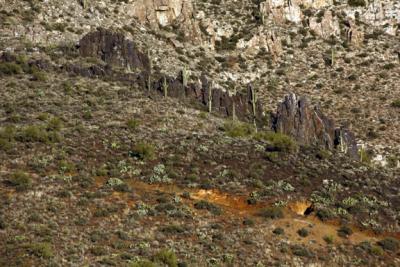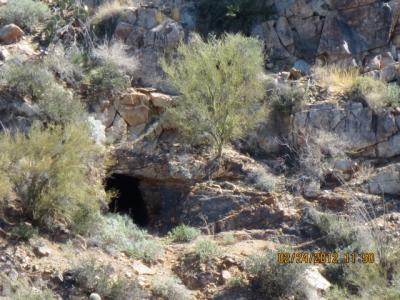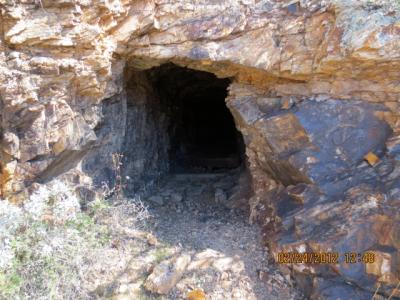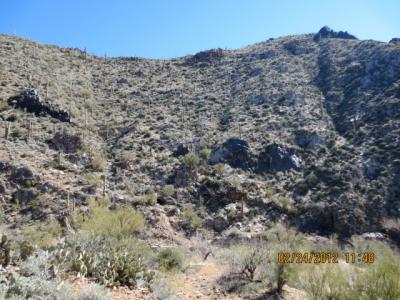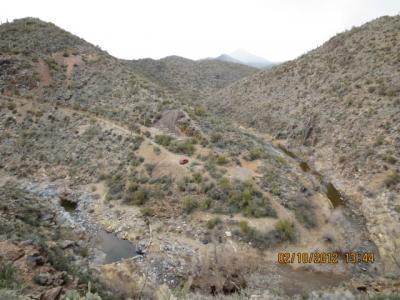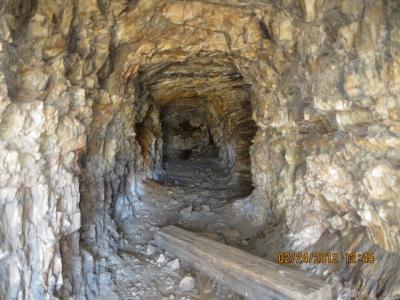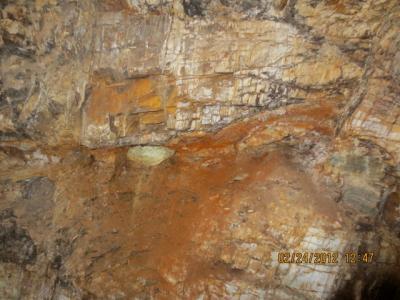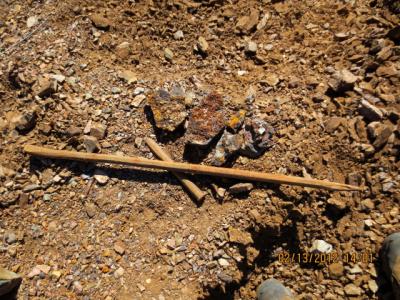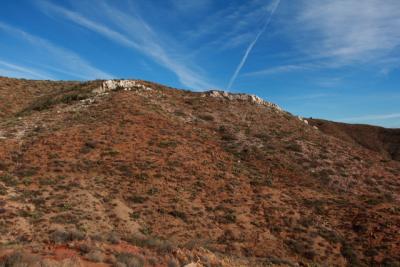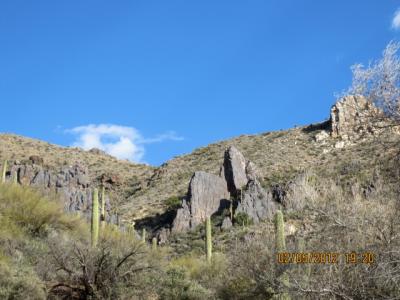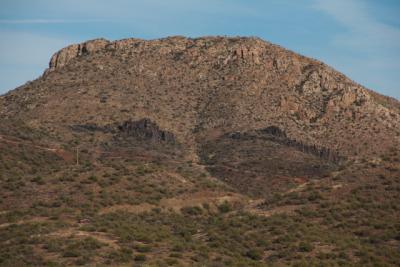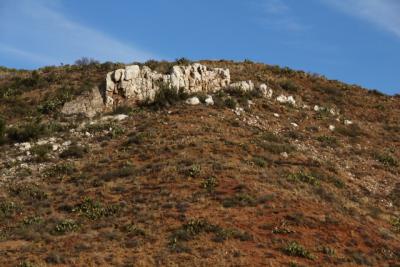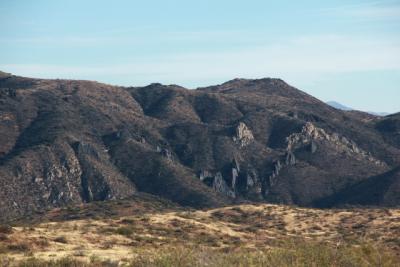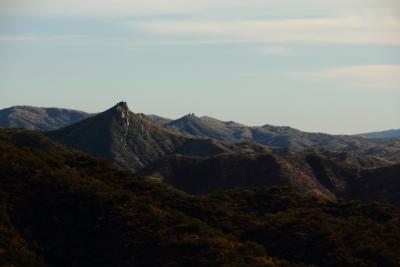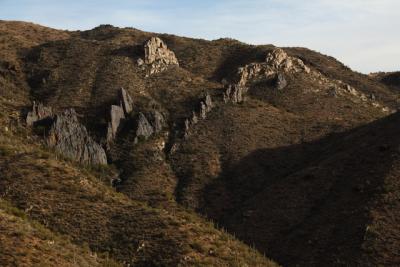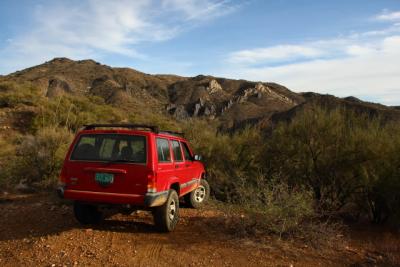
beardog
Full Member-
Posts
68 -
Joined
-
Last visited
Content Type
Forums
Detector Prospector Home
Detector Database
Downloads
Everything posted by beardog
-
Has anyone heard of these batteries? If so, where are they available? I read a thread on Findmall (White's main detector forum) and it sounds like these batteries can give an edge to a detector. Also, it is claimed they last a loooong time.
-
Nice Little 2 Gram Nugget [Taking Photos]
beardog replied to cabelafella's topic in Detector Prospector Forum
First of all, this photo has a very shallow depth of field - a small "depth of field" area of the photo that is crisp and sharp. The higher the F stop (aperture setting) say F16 instead of say F5.6, the sharper the whole image will be, but the focal point must be established by understanding the focal distance from lens to object. (hard to explain this technique shorter than book length - study focal length and depth of field.) The higher the F stop the slower the shutter speed - shooting in manual is the best approach - shooting in auto mode will not get as good results. It was correct in using a 50mm macro for this shot and getting up close BUT a higher magnification lens, say 300mm, at a further distance, zoomed in and as close as possible while maintaining focus and using a higher F stop would give much better results. Also, lens quality is very important. If your 50mm lens is "consumer" quality, all your efforts might be futile, never being able to accomplish your desired clarity, ever. If you are shooting in jpeg you are losing quality. Every time you open/edit a jpeg you lose quality. Raw mode should be used. (usually found only in pro equipment) When working with a raw image you get the benefit of zero lose of quality. Adjusting color, contrast, sharpness, cropping and highlights will be very lossy when in jpeg but is no problem when in raw. The image, once edited, can then be converted to jpeg for web use. (Be sure to copy the raw image and save the original before converting) Lighting should be carefully considered. On camera flash is not the last way to go. This will make for a 'flat" photo and also a "contrasty" photo. Also, out in the bright sun is not the best. To give depth to any image more than one light source is needed. A main light coming from over the should, say from 2 o - clock and then a fill light from the other side and a bit lower will give best results. This will give the subject matter depth. The second photo posted in this thread has that nugget looking flat. The goal in photography is to light the subject in a way that has 2 dimensions. Camera angle can also be adjusted lower in that photo and another light or bounce card could have been used for a second light or "fill" light. I've gotta run - -
Makro Gold Racer 56 kHz - Coming Soon!
beardog replied to Nokta Detectors's topic in Nokta / Makro Metal Detectors
and the new "gold rush" will begin in 5...4...3...2........ -
Like Steve has said many times, "it's not the machine, it's the man behind the machine." Many noobies forget the three cardinal rules for detecting, Ground balance, Thold and coil swing speed. Yes, they just want to find gold and are taken by manufacturer ads of, "our machine will find more gold!" Unfortunately, they fall flat on their face and become discouraged, or, will resort to trespass to better their chances - claim stakes, how dare someone put up claim stakes! It took me many years to learn "low and slow" but when the electronic gold rush started, well, I listened and learned. Once again, hats off for Steve's generous web site!!!
-
How Do You Deal With Claim Jumpers?
beardog replied to Rick Watkins's topic in Detector Prospector Forum
Whew! For a while there I thought there was going to be a lynching! Nothing has changed in the last 175 years, it's still the same old argument. Steve is right, "most people couldn't find gold if their lives depended on it." Remember one thing my friends, when the prospecting community advertises their products with "find more gold nuggets with our machine" - this starts a fever, the gold rush begins. Some of these types get discouraged after a few tries and some of these folks get resentful, holding a grudge against claim holders. Sometimes, these people with a grudge will go to great extent to "get rich quick" and they don't care who's claim they are on, they are driven by that burning fever. Nothing has changed over time where gold is concerned. There will always be those who work hard, take their licks and become successful and those who have no knowledge of gold but can buy the latest "sure to have success" detector and strike out to find their fortune, ignoring the harsh reality of all the "hard work" that is the key to success. Staking a claim is the civilized thing to do and respecting those mineral rights is the respectable thing to do. So, let's be civilized. Respect all those "PVC pipes". Those "white papers" have contact info on them. This has helped me get permission to hunt many times. Also, people have a right to recreate on public land. The only thing that should be of concern is what their activity on that land is. -
Sulfides That Burn By Themselves?
beardog replied to tvanwho's topic in Rocks, Minerals, Gems & Geology
Not sure if this is the answer but may give some clues: hydrogen sulfide, chemical compound, H2S, a colorless, extremely poisonous gas that has a very disagreeable odor, much like that of rotten eggs. It is slightly soluble in water and is soluble in carbon disulfide. Dissolved in water, it forms a very weak dibasic acid that is sometimes called hydrosulfuric acid. Hydrogen sulfide is flammable; in an excess of air it burns to form sulfur dioxide and water, but if not enough oxygen is present, it forms elemental sulfur and water. Hydrogen sulfide is found naturally in volcanic gases and in some mineral waters. It is often formed during decay of animal matter. It is a part of many unrefined carbonaceous fuels, e.g., natural gas, crude oil, and coal; it is obtained as a byproduct of refining such fuels. It may be made by reacting hydrogen gas with molten sulfur or with sulfur vapors, or by treating a metal sulfide (e.g., ferrous sulfide, FeS) with an acid. Hydrogen sulfide reacts with most metal ions to form sulfides; the sulfides of some metals are insoluble in water and have characteristic colors that help to identify the metal during chemical analysis. Hydrogen sulfide also reacts directly with silver metal, forming a dull, gray-black tarnish of silver sulfide (Ag2S). -
Magnetic Properties Of Rocks And Minerals
beardog replied to Steve Herschbach's topic in Rocks, Minerals, Gems & Geology
This chart has "massive" information, massive being the key word here. In simple terms, these samples are of one mineral each, formed thru a cooling process that deposited "pure" minerals but did not form crystals, the exception being the sedimentary rocks. In the real world we have a much more complex set of rocks to deal with, some rocks being made up of many different minerals, such as magnetite in quartz or garnet, pyrite, feldspar,magnetite in schist, for example. Massive samples are easy to identify but the more complex rock structures take a bit more knowledge and testing to identify, sometimes being made up from several different minerals. Sometimes these mineral groupings can be seen with the human eye and sometimes a loupe is required. So, if you beep a rock and want to know why it beeped, break the rock to expose a clean surface and have a look with a loupe. It may not be a massive sample, but, might be many different minerals. Also, the listings should have been - sedimentary, metamorphic then igneous. -
The photo above is a good example of the geology I am trying to present in this thread. In my first thread, "Dikes along Turkey Creek", I touched upon the heating and cooling processes that occur during the uplift/intrusion process. Keeping in mind the cooling process that create ore deposits, you can see in the photo that the tunnel is well below the exposed dikes above, the exposed dikes having cooled more quickly eliminating the formation of precious metals and crystals. Also, notice the red soil at the tunnel entrance. Above is a close up of another tunnel A wider view of the above tunnel Here is yet a wider view of the tunnel. About a third of the way up in the photo and slightly left of center is the tunnel entrance. Notice the dikes that are up high and then the lower dikes. Those lower dikes are much more mineralized, due to the slower cooling process. The lower dikes were exposed by the cutting action of the creek (Turkey Creek). This photo is a wider view, taking in the river, shot from the upper dike that is seen in the previous photos. The tunnel entrance is just off camera in the lower right corner. This photo demonstrates the cutting action of the creek. Over time, cutting down nearly 3 hundred feet, exposing the ore body where this tunnel is located. (can you imagine being the first person to stumble across this?) inside the tunnel - as far as I dared go - notice the "drifts", one to the left and one to the right. the photo above is of the side wall in the tunnel - very hot indeed! A bar (36 in) and a chisel (8 inch) found while raking thru the tailings. Also, notice how mineralized these tailings are. I found no gold in those tailings but many quartz crystals. So, the moral of this story is, when you are standing next to an Iron Stone Dike, look below, much further below.
-
tvanwho - I would encourage you to join a club if your planning to spend some time in Az. As in any gold country, the land will be claimed. I joined the Roadrunners Prospecting Club before I headed out. They have an extensive holding of claims thru out Az. Many of their claims adjoin BLM and Forest Service land where there is much unclaimed land to hunt on. Red soil, for me, has to have other indicators before I invest more than just a quick look. I want to see quartz, iron stone and other igneous indicators. Red soil is not a definitive marker for gold - all red soil is not created equal. I used a PI machine while I was out there, a Garrett Infinium LS with 8 inch mono coil. It worked well for me in that hot soil. I'm not saying a VLF won't work, if you know your machine and the audio tones. And, I did not haul water to pan with. I keep a Garrett SP 14 gold pan in my pack. Dry panning is most easily accomplished with a pan that has a large bottom area - such as the SP 14 or their Super Sluice pan. Along with the pan I carry a piece of 1/4 inch hardware cloth to classify with. I cut a 14 inch diameter circle from the hardware cloth so it fits nicely in the pan. My next big adventure is going to be to NorCal. I am a life member of the New 49'ers and have my sights set on Happy Camp for 2016. HH Bro!
-
tvanwho - At first I focused on detecting around the base of these dikes but soon learned, the simple thing was to "test" the washes down lower. Don't forget, nature has her obstacles! I did climb to look closely at these dikes, especially if I could see any quartz veins in them. The time required to get to some of these dikes was an investment, Also, navigating thru the terrain, cactus, greasewood and every other bush that held thorns, along with the jumping cholla, well, it took time. I will say I always had the best luck in the red soil. Also, I found ancient stream beds up high that yielded some of the bigger finds but they were well below the dikes. I am getting more photos ready to upload. The Tunnels - I will explain more about what I learned in that thread. chickenminer - I hated to leave! I have never felt more free at any time in my life. Rock hounding is always a good way to track down gold. I found some nice crystals while hiking in those mountains, leading me to very mineralized grounds. Sometimes we have to pay attention to what is right under our feet. It might not be gold underfoot but what is underfoot can give some great clues. I've never met a nugget I didn't like!
-
Tesoro Silver uMax Pinpointer Conversion
beardog replied to Steve Herschbach's topic in Compass, D-Tex, Tesoro, Etc.
Ha! I always thought of the GB2 as a pin pointer on steroids. Nice mod Steve, very nice! -
Dikes are formed during the uplift, the interaction between oceanic and continental crust pushing together, like a folding of the land. The basalt dikes are from the country rock, or, the crust of the earth. The Iron Stone dikes (the black dikes) are intrusions of magma, forced up into voids in the country rock after the uplift. These intrusions are where all minerals are formed, depending upon how hot the intrusion is and how the cooling process takes place (slower cooling always produces more minerals and crystals) gold can form along with many other precious metals. Keep in mind that the mountains in the east are much older than the mountains in the west, having worn down many degrees more than, say, the Rockies or Sierras. Eastern gold is very old and has been ground down into flour over the eons of erosive processes.
-
Gold Bug 2 14" Coil Performance
beardog replied to LukeOzDigger's topic in First Texas - Bounty Hunter, Fisher & Teknetics
I agree - pick your ground carefully. -
Tortuga - there's gold in them thar hills! In the draws and washes where I managed to beep some crumbs I would also be able to dry pan and find more. Unfortunately, distance to travel on foot was extreme. Packing in dry washers or high bankers was out of the question. Sometimes, as night was falling, I would have to make a camp for the night, being as much as 12 miles out. Hiking thru that country in the dark did not interest me. Many times I would go on 3 day journeys spending 2 nights in the splendor of nature. There are so many draws and washes in that country it is not possible to hunt them. My approach was to check the bottoms of each one that caught my interest. Maybe I would hunt up them a way but I would usually have a destination in mind, my focus being to follow my plan. I'm sure if a man wanted to strike it rich that would be the country to do it in. My gut feeling is, there are places out there that hold a lot of gold. Problem is, a man could spend a lifetime out there and not find it. It's just that big! When I get time I will post more photos, next time - "the tunnels". HH Bro
-
Gold Bug 2 14" Coil Performance
beardog replied to LukeOzDigger's topic in First Texas - Bounty Hunter, Fisher & Teknetics
A 14 inch coil on a GB2??? I don't get it. Other than covering more ground this makes no sense to me. Steve didn't say how deep the nuggets were he found. That would be of interest. Kind of like putting a 4 inch puck on a Zed. Probably I'm wrong but it seems that trying to go beyond it's intended use (finding shallow small gold) should give reason to reconsider. -
I haunted the Northern Bradshaws during my trip to Az in the winter of 2012 - 13. One of the things that had me amazed were all the Dikes. I was drawn to them and gave them all a visit. Many times I went away empty handed but never without amazement. Turkey Creek, and surrounding area, had me wanting for more. I just could not get enough, entertaining the fantasy of buying a mule and disappearing into the hills. I could not believe how mineralized this area is. From Cleator down thru Turkey Creek, Black Canyon and surrounding area was like an Alice in Wonderland experience. What we see in these photos is Iron Stone and what I think are Basalt dikes. The Iron Stone usually projects below the Basalt dikes. During my research on the Bradshaw Mnts. I learned that these mnts., since their creation, have eroded down from 100 - 400 ft. Any alluvial deposits from that erosion happened many, many eons ago. These deposits, along with exposed hard rock veins have been worked and worked over and over. But guess what, there is still much to be found. I had my good days, hiking out with my pickers and, many days, I hiked out with a skunk.
-
3 feet deep, now that's impressive! I've watched a lot of Zed vids on youtube where people have dug nothing that a PI or VLF could not find. Is this the "needle in the hay stack" or will we be hearing about more of these deep finds? I guess dink's are better than nothing but this is exciting news. Let the gold rush begin!
-
I am never totally disappointed in any detector I purchase. Basically, the disappointment I have is the design. The S shaft has to go and I see the FORS Gold+ is falling in line with that design. I think those folks have been listening. I have 4 machines from 3 different companies, trying to cover all the bases. One PI, one high frequency VLF, one mid range frequency VLF and one low frequency. Because of design, Nokta has my attention, big time. I don't think, "it is just another VLF machine." I think it's another VLF machine that is well designed and will give a better experience at the end of the day. After more reports come in from the field I will take the plunge. I am hoping it is as comfortable as I think it is. Also, a longer warranty would be very nice. Kill the S shaft!
-
Fors Gold + Expected Ship Date
beardog replied to Nokta Detectors's topic in Nokta / Makro Metal Detectors
I'm in! I've been looking at this machine since the first post was made. I really like the build, that upright grip and the under elbow box, keeping everything in line for a natural wrist position. A straight shot from the elbow to the coil. I like it. Hope it feels as good as it looks. If the FORS Gold+ was water proof it would be a niche machine, for me. -
Why My Gold Is In A Safe Deposit Box
beardog replied to Steve Herschbach's topic in Detector Prospector Forum
Yup, I like the old saying, "never cast your pearls before swine". I like my waterproof, Schedule 40, sub-terrain, security device. I've been doing this for years. It is the only thing I trust. It's interesting, over the years rumors have started and a "tale of buried treasure" has evolved. One time a friend asked me if he could see my gold. I told him it was buried. That was 14 years ago. Then, one day, I stopped in at the local watering hole (3 - 4 years later) and heard some locals talking about gold buried up on the ridge. They did not know me and I did not join in. I just smiled and thought about how much these stories can grow. The yarn had been stretched quite a bit! I'm lucky to own 27 acres up on that ridge. It's real secure - -
Thank YOU Steve! Finally, someone has made it very clear in laymen terms. I have recently switched brands, the process was daunting because of all the hype and my lack of knowledge around how detectors work. Not having the $$$ to lay out for the big OZ machines I struggled to get into a brand that would give me confidence at my level of knowledge. My choice of the GMT was based on what I learned on YOUR site. I am grateful for your generous sharing of info and also your honest and direct evaluation of machines. If the release of the new Nokta had been a couple months ago, I might be swinging that machine right now but have no regrets about the one I bought. It goes down the road well, now I have learned the tweaks. It's a jungle out there. I'm happy I found a good guide!
-
The site loaded ok for me. Not as snappy as Steve's site but hey, it's a virgin site. I use a Mac with Safari as browser and it's about 10 years old. I love all the flicks from "gold country"! Great work Ray - keep it coming! Good stuff to gnaw on during the cold winter days -
-
Point taken jasong - just trying to understand why one machine is claimed to be so much more powerful than another.
-
A small voltage system does not require the same wire gauge as a large voltage system. For instance, I could wire my house to 12 volt using a smaller wire size than if I wired my house to 110 volt. This would reduce cost and provide for a more proprietary electric system. I would not plug a 220 electric motor into a 110 outlet, it would cause heating and a hazard. Would you prefer more volts and higher wire gauge or less volts and lighter wire gauge? The end result of higher volts is, more power. It's like supplying water to a source thru piping. If that source requires X amount of water over X amount of time would you rather have a straw or would you rather use a garden hose? If that source was a large tank that needed X amount of time to be filled, you would have to match the pipe size to the time required to fill the tank. So it is with volts thru wires, the amount of supplied power to the end user - the coil.
-
This machine runs on 6 volts. GBP runs on 9 volts. The GMT runs on 12 volts. For now, I'll stick with the GMT. Not only because I think it makes for a hotter machine but also longer in field use on one set of batteries. When I look at the BIG minelabs I am attracted to the large batteries. To bad I never have the money for something that has the power I would like. You've got to have the juice if you're going to pry them loose!

